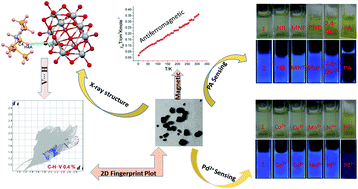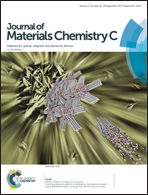New hybrid polyoxovanadate–Cu complex with V⋯H interactions and dual aqueous-phase sensing properties for picric acid and Pd2+: X-ray analysis, magnetic and theoretical studies, and mechanistic insights into the hybrid's sensing capabilities†
Abstract
Apart from traditional metal–organic frameworks as sensory materials, materials incorporating discrete cages or clusters to sense hazardous species are uncommon. Keeping this view in mind, a new hybrid discrete material comprising a decavanadate anion and copper complex cations was designed for such a purpose. Consequently, a novel polyoxovanadate (POV)-based inorganic–organic hybrid compound showing a unique combination of first anagostic (V⋯H) interactions was synthesized. Single-crystal X-ray data ascertained the bonding modes and geometry of the complex along with the novel anagostic weak intermolecular interactions in the complex material. X-ray crystallography confirmed the composition of the cluster as {Cu(Pyno)4}{NEt3H}2[H2V10O28] (1), containing a decavanadate unit as the anion with a square planar copper(II) complex and triethylaminium as the cations. The complex was further characterized by FT-IR, time decay and magnetic studies. The magnetic studies confirmed the presence of the Cu2+ state in the complex at room temperature as well as at low temperature. The cluster displayed rare intermolecular V⋯H, lp⋯π, V–O⋯H, π⋯π and C–H⋯H interactions, which generated a supramolecular framework. These interactions were verified by Hirshfeld surface analyses. The hybrid material is reported herein as the first aqueous-phase sensor for picric acid (PA) as well as for Pd2+. The complex showed a highly sensitive, discriminative and selective sensing behaviour for the said species and is the first reported example of its type in this discrete molecular category. The sensing pathways were investigated by spectral titrations, and by time decay and DFT (B3LYP/def2-SVP) studies. The lowest detection limit was discovered for the present POV towards the sensing of both PA and Pd2+ ions with values of ∼0.18 and ∼0.80 ppb, respectively.



 Please wait while we load your content...
Please wait while we load your content...